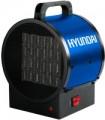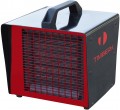Rated current
The current consumed by the heat gun during normal operation. This parameter is useful primarily for assessing the load on the mains that occurs during the operation of the unit and organizing the appropriate connection. In particular, the rated current of the fuse installed in the connection circuit cannot be lower than the total rated current of the connected load — otherwise, the power will be turned off. Heat guns (primarily electric, see "Power supply") are quite high consumption consumers in terms of current.
Features
—
Temperature control. The ability to change the heating temperature provided by the industrial heater. This function allows you to optimally adjust the operation of the device to the necessary conditions and heating intensity.
—
Thermostat. A thermostat is a device for maintaining the air temperature at the same level. The principle of operation of this device is as follows: when the required air temperature is reached, it automatically turns off the heating, and when it gets cold, it turns it on again until the air warms up sufficiently. The temperature of the thermostat operation, usually, is set by the operator of the heater.
—
Piezo ignition. The presence of a piezoelectric ignition system in the design of the industrial heater. In such systems, the spark necessary to ignite the fuel is generated by the operation of a piezoelectric generator, and its operation is based on the use of a special material that, when bent, generates an electric current. It means that no external power is required for ignition — the necessary energy is generated by the operator himself when the button is pressed. In addition, piezoelectric systems are considered very convenient for several other technical reasons. They are found mainly in gas industrial heaters (see "Power supply") because, for diesel fuel, such ignition is poorly suited.
—
Complete fuel combustion. This feature is found in gas and diesel models (see "Power supply"). It means that the fuel in the combustion chamber of the heater burns out completely, without forming soot and other by-products and practically without creating unpleasant odours. In addition, it has a positive effect on efficiency. This feature is especially important for diesel units because diesel and many types of liquid fuels are "dirtier" than gas and more prone to soot. Smokeless combustion facilitates the use of heaters in rooms where there are people — however, note that it does not cancel the requirements for good ventilation, since combustion products still need to be removed from the air.
— Fan mode. The ability to operate the heater in the ventilation-only mode, when the device circulates air but does not warm it up. The purpose of this function is obvious: situations when the room is already warm enough, or heating is not required for other reasons.
— Fuel level indicator. The presence in the design of a diesel heater of a sensor that signals the amount of fuel in the tank. The design and operation of this sensor may vary from model to model: in some devices, it constantly displays the remaining fuel; in others, it plays the role of an alarm and turns on only when the fuel level drops below a certain value. However, this feature makes it easier to monitor the condition of the unit and prevents troubles associated with unexpected emptying of the tank.
— Air filter. The presence of an air purification filter in the design of a diesel heater. One of the “weaknesses" of such units is the nozzles that supply the fuel-air mixture to the combustion chamber; contaminants that enter these nozzles clog them and can even disable them. The air purification filter prevents such troubles: it traps dust, sand and other mechanical impurities, ensuring stable operation and durability of the injectors.
Protection class (IP)
An indicator that determines the degree of protection of dangerous (moving and current-carrying) parts of an industrial heater from adverse effects, namely solid objects and water. The level of protection is usually indicated by a marking of the letters IP ("ingress protection")) and two numbers, the first of which indicates protection against the effects of solid objects, and the second — against the ingress of water.
For the first digit, each value corresponds to the following protection values:
1 — protection against objects with a diameter of more than 50 mm (large body surfaces)
2 — from objects with a diameter of more than 12.5 mm (fingers, etc.)
3 — from objects larger than 2.5 mm (most instruments)
4 — from objects more than 1 mm (almost all tools, most wires)
5 — dustproof (full protection against contact; dust can penetrate inside, but does not affect the operation of the device)
6 — dust tight (case with full protection against dust and contact).
For the second digit:
0 — completely unsuitable for contact with water, the device requires protection from moisture and is not suitable for rooms with high humidity.
1 — protection against vertically falling drops of water
2 — from water drops with a deviation of up to 15 ° from the vertical axis of the device
3 — from water drops with a deviation of up to 60 ° from the vertical axis of the device (rain)
4 — against splashes from any...direction 5 — against jets from any direction
6 — from sea waves or strong water jets
7 — the possibility of short-term immersion to a depth of 1 m (without the possibility of continuous operation in immersed mode)
8 — the possibility of long-term immersion to a depth of more than 1 m (with the possibility of continuous operation in immersed mode).
The protection class of industrial heaters, usually, is quite low, because the very principle of operation of these devices involves an abundance of holes and openings.
Noise level
The maximum noise level produced by the industrial heater during normal operation. For comparison, 50 decibels roughly corresponds to the noise in an office room, 60 dB to an average TV volume, 70 dB to a truck at a distance of about 8 m, 80 dB to traffic noise, and 90 dB to a scream. The lower the noise level, the more comfortable the use of the unit, especially when placed close to people or in echoing rooms where the sound does not fade for a long time.

